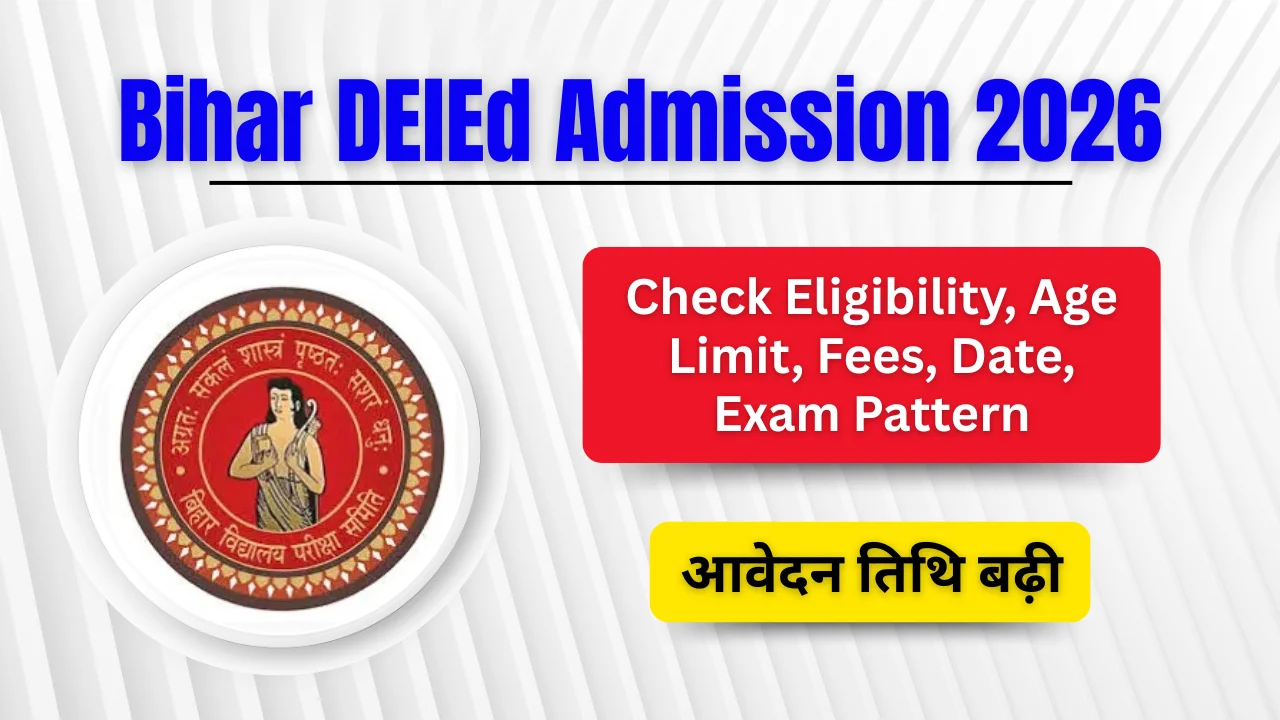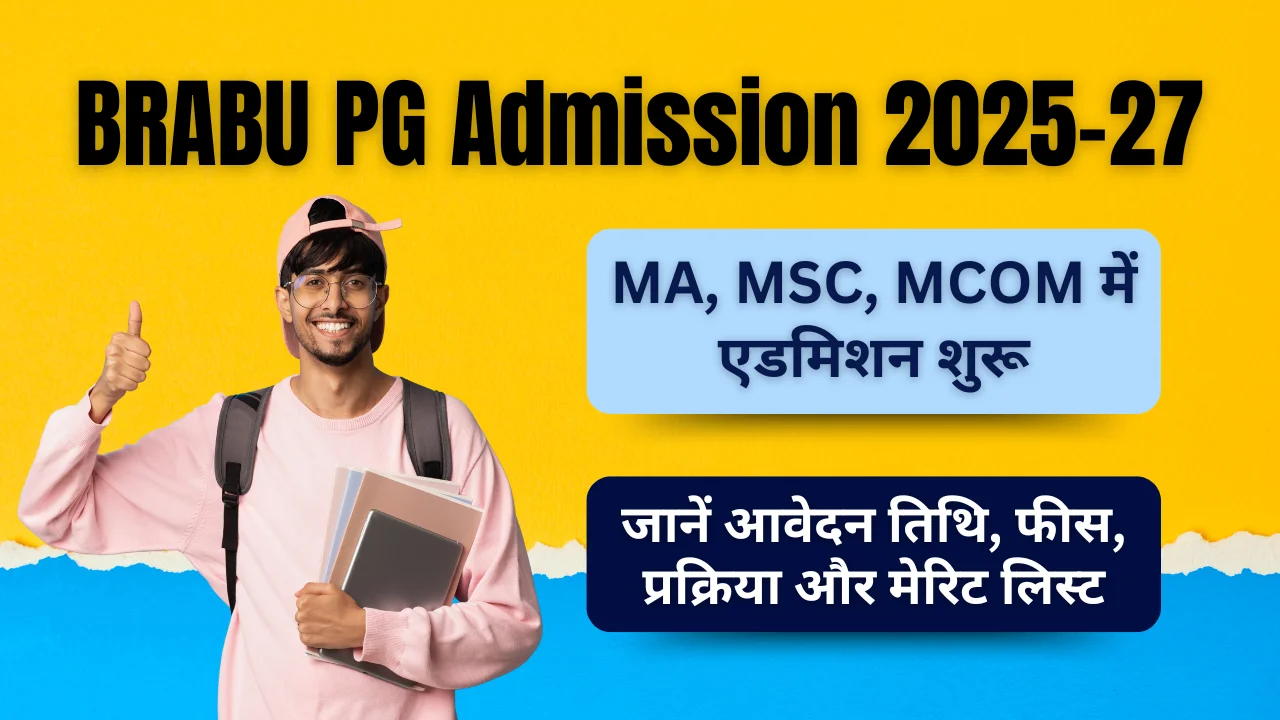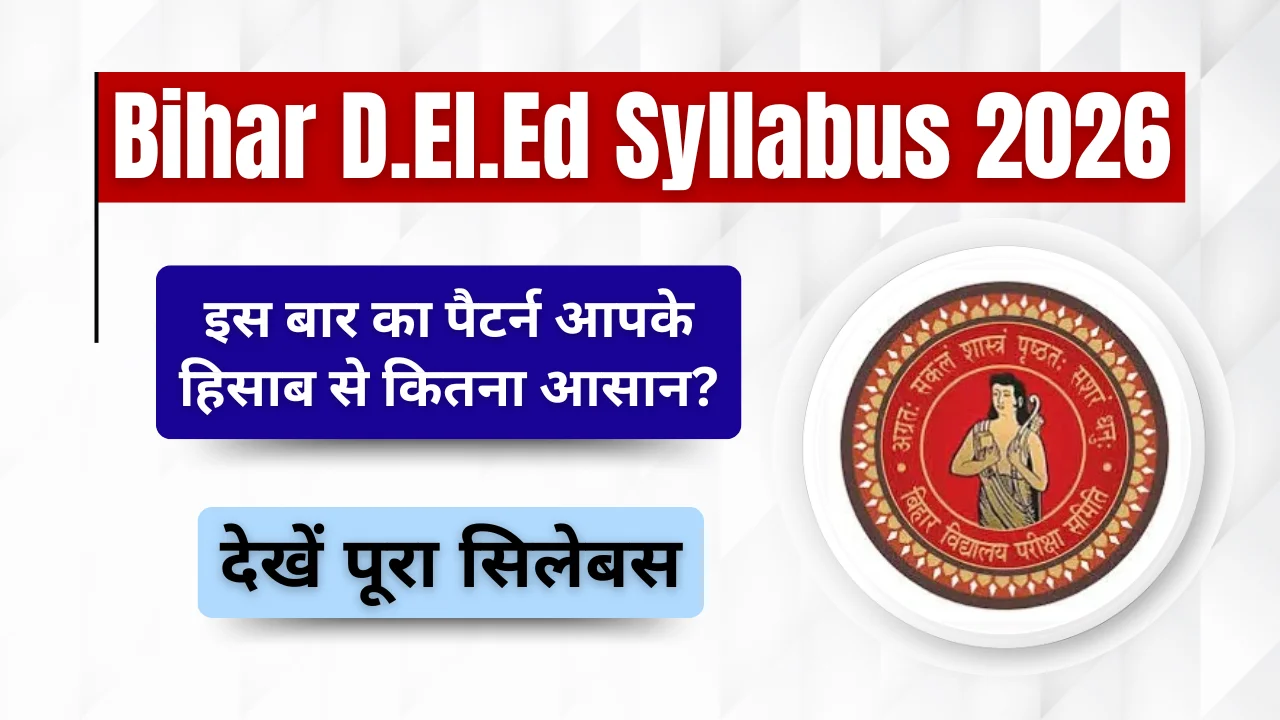In this NCERT Solutions for Class 10 Science Chapter 13 contain the following topic and we will study magnetic fields and such electromagnetic effects, along with electromagnets and electric motors which involve the magnetic effect of electric current, and electric generators and more. These are the main topic that we covered in this chapter Magnetic field, field lines, field due to a current carrying conductor, field due to current carrying coil or solenoid, Force on current carrying conductor, Fleming’s Left Hand Rule, Electric Motor, Electromagnetic induction. Induced potential difference, Induced current. Fleming’s Right Hand Rule.
ALSO CHECK – Download the free Class 10th Notes here
Students who are preparing for their Class 10 exams and searching for chapter-wise NCERT Solution for Class 10 Science must go through NCERT Solutions for Class 10 Science Chapter 13 Magnetic Effects of Electric Current. Checkout previous chapter – NCERT Solutions for Class 10 Science Chapter 11 Human Eye and Colourful World
Also Check – NCERT Solutions for Class 9 Maths
NCERT Solutions for Class 10 Science Chapter 13 In-text Questions
Page No.- 224
Question 1
Why does a compass needle get deflected when brought near a bar magnet ?
Answer:
The compass needle is a small magnet. When the compass needle is brought close to a bar magnet, the magnetic field lines of the compass needle interact with the magnetic field lines of bar magnet, which causes the compass needle to deflect.
Page No.- 228
Question 1
Draw magnetic field lines around a bar magnet.
Answer: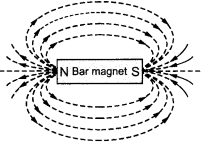
Question 2
List the properties of magnetic lines of force.
Answer:
Properties of magnetic lines of force :
- Magnetic field lines do not intersect with each other.
- They emerge from the North Pole and terminate at the South Pole.
- Inside the magnet, the direction of the field lines is from the South Pole to the North Pole.
Question 3
Why don’t two magnetic lines of force intersect each other ?
Answer:
If two magnetic field lines intersect then at the point of intersection the compass needle shows two different directions, which is not possible, hence they do not intersect with each other.
Page No.- 229 – 230
Question 1
Consider a circular loop of wire lying on the plane of the table. Let the current pass through the loop clockwise. Apply the right hand rule to find out the direction of the magnetic field inside and outside the loop.
Answer:
As shown in figure alongside, each section of wire produces its concentric set of lines of force. By applying right hand thumb rule, we find that all the sections produce magnetic field downwards at all points inside the loop while at the outside points, the field is directed upwards. Therefore, the magnetic field acts normally into the plane of the paper at the points inside the loop and normally out of the plane of paper at points outside the loop.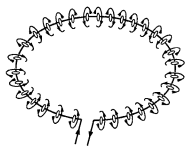
Question 2
The magnetic field in a given region is uniform. Draw a diagram to represent it. [CBSE 2013, 2014]
Answer:
A uniform magnetic field in a region is represented by drawing parallel straight lines, ail pointing in the same direction.
For example, the uniform magnetic field which exists inside a current-carrying solenoid can be represented by parallel straight lines pointing from its S-pole to N-pole (as shown in figure).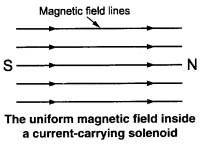
Question 3
Choose the correct option.
The magnetic field inside a long straight solenoid-carrying current
(i) is zero
(ii) decreases as we move towards its end
(iii) increases as we move towards its end
(iv) is the same at all points
Answer:
(iv) Is the same at all points.
Page No.- 231 – 232
Question 1
Which of the following property of a proton can change while it moves freely in a magnetic field. (There may be more than one correct answer.)
(i) Mass
(ii) Speed
(iii) Velocity
(iv) Momentum
Answer:
The correct options are (iii) velocity, (iv) momentum.
Question 2
In Activity 13.7 how do we think the displacement of rod AB will be affected if (i) current in rod AB is increased (ii) a stronger horse-shoe magnet is used; and (iii) length of the rod AB is increased ?
Answer:
(i) When the current in the rod AB is increased, force exerted on the conductor increases, so the displacement of the rod increases.
(ii) When a stronger horse-shoe magnet is used, the magnitude of the magnetic field increases. This increases the force exerted on the rod and the displacement of the rod.
(iii) When the length of the rod AB is increased, force exerted on the conductor increases, so the displacement of the rod increases.
Question 3
A positively-charged particle (alpha particle) projected towards west is deflected towards north by a magnetic field.
The direction of magnetic field is :
(i) towards south
(ii) towards east
(iii) downward
(iv) upward
Answer:
(iv) Upward.
The direction of the magnetic field can be determined using the Fleming’s Left hand rule. According to the rule, if we arrange our thumb, forefinger and the middle finger of the left hand right perpendicular to each other, then the thumb points towards the direction of the magnetic force, the middle finger the direction of current and the forefinger the direction of magnetic field. Since the direction of positively charged particle is towards west, the direction of the current will also be towards the west. The direction of the magnetic force is towards the north, hence the direction of magnetic field will be upward according to Fleming’s Left hand rule.
Page No.- 233
Question 1
State Fleming’s left hand rule. [CBSE 2018]
Answer:
Fleming’s left hand rule : Fleming’s Left hand rule states that if we arrange our thumb, forefinger and middle finger of the left hand at right angles to each other, then the thumb points towards the direction of the magnetic force, the forefinger points towards the direction of magnetic field and the middle finger points towards the direction of current.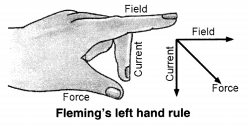
Question 2
What is the principle of an electric motor ? [CBSE 2018]
Answer:
A motor works on the principle of magnetic effect of current. When a rectangular coil is placed in a magnetic field and current is passed through it, a force acts on the coil which rotates it continuously.
When the coil rotates, the shaft attached to it also rotates. In this way the electrical energy supplied to the motor is converted into the mechanical energy of rotation.
Question 3
What is the role of the split ring in an electric motor ?
Answer:
The split ring reverses the direction of current in the armature coil after every half rotation, i.e., it acts as a commutator. The reversed current reverses the direction of the forces acting on the two arms of the armature after every half rotation. This allows the armature coil to rotate continuously in the same direction.
Page No.- 236
Question 1
Explain different ways to induce current in a coil.
Answer:
Different ways to induce current in a coil are :
- If the coil is moved rapidly between the two poles of horse shoe magnet, electric current is induced in the coil.
- When a magnet is moved relative to the coil, an electric current is induced in the coil.
Page No.- 237
Question 1
State the principle of an electric generator.
Answer:
The electric generator works on the principle that when a straight conductor is moved in a magnetic field, then current is induced in the conductor.
In an electric generator, a rectangular coil is made to rotate rapidly in the magnetic field between the poles of a horse-shoe type magnet. When the coil rotates, it cuts the magnetic field lines due to which a current is produced in the coil.
Question 2
Name some sources of direct current.
Answer:
DC generator and cell are some sources of direct current.
Question 3
Which sources produce alternating current ?
Answer:
AC generators of nuclear power plants, thermal power plants, hydroelectric power stations, etc.
Question 4
Choose the correct option : A rectangular coil of copper wires is rotated in a magnetic field. The direction of the induced current changes once in each:
(i) two revolution
(ii) one revolution
(iii) half revolution
(iv) one-fourth revolution
Answer:
(iii) Half revolution.
Page No.- 238
Question 1
Name two safety measures commonly used in electric circuits and appliances.
Answer:
(i) Earthing and
(ii) Electric fuse.
Question 2
An electric oven of 2 kW power rating is operated in a domestic electric circuit (220 V) that has a current rating of 5 A. What result do you expect ? Explain.
Answer:
The electric oven draws a current given by![]()
Thus the electric oven draws current much more than the current rating 5 A. That is the circuit is overloaded. Due to excessive current, the fuse wire will blow and the circuit will break.
What precautions should be taken to avoid the overloading of domestic electric circuits ?
To avoid the overloading of domestic electric circuits, the following precautions should be taken :
(i) The wires used in the circuit must be coated with good insulating materials like PVC, etc.
(ii) The circuit must be divided into different sections and a safety fuse must be used in each section.
(iii) High power appliances like air-conditioner, refrigerator, a water heater, etc. should not be used simultaneously.
NCERT Solutions for Class 10 Science Chapter 13 Textbook Chapter End Questions
Question 1
Which of the following correctly describes the magnetic field near a long straight wire ?
(i) the field consists of straight lines perpendicular to the wire
(ii) the field consists of straight lines parallel to the wire
(iii) the field consists of radial lines originating from the wire
(iv) the field consists of concentric circles centred on the wire
Answer:
(iv) The field consists of concentric circles centred on the wire
Question 2
The phenomenon of electromagnetic induction is
(i) the process of charging a body
(ii) the process of generating magnetic field due to a current passing through a coil
(iii) producing induced current in a coil due to relative motion between a magnet and the coil
(iv) the process of rotating a coil of an electric motor
Answer:
(iii) Producing induced current in a coil due to relative motion between a magnet and the coil
Question 3
The device used for producing electric current is called a
(i) generator
(ii) galvanometer
(iii) ammeter
(iv) motor
Answer:
(i) Generator.
Question 4
The essential difference between an AC generator and a DC generator is that
(i) AC generator has an electromagnet while a DC generator has permanent magnet
(ii) DC generator will generate a higher voltage
(iii) AC generator will generate a higher voltage
(iv) AC generator has slip rings while the DC generator has a commutator
Answer:
(iv) AC generator has slip rings while the DC generator has a commutator
Question 5
At the time of short circuit, the current in the circuit
(i) reduces substantially
(ii) does not change
(iii) increases heavily
(iv) varies continuously
Answer:
(iii) Increases heavily.
Question 6
State whether the following statements are True or False.
(i) An electric motor converts mechanical energy into electrical energy.
(ii) An electric generator works on the principle of electromagnetic induction.
(iii) The field at the centre a long circular coil carrying current will be parallel straight lines.
(iv) A wire with a green insulation is usually the live wire of an electric supply.
Answer:
(i) False
(ii) True
(iii) True
(iv) False.
Question 7
List three sources of magnetic fields.
Answer:
(i) Current carrying conductor
(ii) Electromagnets
(iii) Permanent magnets
Question 8
How docs a solenoid behave like a magnet ? Can you determine the north and south poles of a current-carrying solenoid with the help of a bar magnet? Explain.
Answer:
A solenoid is a long coil of circular loops of insulated copper wire. The magnetic field produced around the solenoid when the current is passed through it is similar to the magnetic field produced around the bar magnet when current is passed through it. The figure shown below shows the arrangement of magnetic fields produced around the solenoid when current is passed through it.

When the north pole of the bar magnet is brought close to the end connected to the negative terminal of the battery, the solenoid repels the battery. As like poles repel each other, we can infer that the end connected to the negative terminal behaves as a north pole while the end connected to the positive terminal behaves as a south pole.
Question 9
When is the force experienced by a current-carrying conductor placed in a magnetic field largest ?
Answer:
When the conductor carries current in a direction perpendicular to the direction of the magnetic field, the force experienced by the conductor is largest.
Question 10
Imagine that you are sitting in a chamber with your back to one wall. An electron beam, moving horizontally from back wall towards the front wall, is deflected by a strong magnetic field to your right side. What is the direction of magnetic field ?
Answer:
Here the electron beam is moving from our back wall to the front wall, so the direction of current will be in the opposite direction, from front wall towards back wall or towards us. The direction of deflection (or force) is towards our right side.
We now know two things :
- direction of current is from front towards us, and
- direction of force is towards our right side.
Let us now hold the forefinger, middle finger and thumb of our left hand at right angles to one another. We now adjust the hand in such a way that our centre finger points towards us (in the direction of current) and thumb points towards right side (in the direction of force). Now, if we look at our forefinger, it will be pointing vertically downwards. Since the direction of forefinger gives the direction of magnetic field, therefore, the magnetic field is in the vertically downward direction.
Question 11
Draw a labelled diagram of an electric motor. Explain its principle and working. What is the function of a split ring in an electric motor ?
Answer:
Electric Motor : The device used to convert electrical energy to mechanical energy is called Electric Motor. It is used in fans, machines, etc.
Principle : NCERT Solutions for Class 10 Science Chapter 13 Magnetic Effects of Electric CurrentElectric motor works on the principle of force experienced by a current carrying conductor in a magnetic field. The two forces in the opposite sides are equal and opposite. Since they act in different lines they bring rotational motion.
Working of an electric motor :
When current starts to flow, the coil ABCD is in horizontal position. The direction of current through armature coil has the direction from A to B in the arm AB and from C to D in the arm CD. The direction of force exerted on the coil can be found through Fleming’s left hand law.
According to this law, it is found that the force exerted on the part AB, pushes the coil downwards. While the force exerted on the part CD pushes it upwards. In this way, these two forces being equal and opposite form a couple that rotates the coil in anticlockwise direction.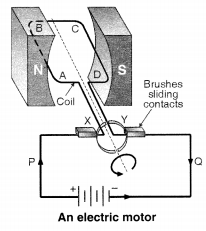
When the coil is in vertical position, the brushes X and Y would touch the centre of the commutator and the current in the coil is stopped. Though current is stopped but the coil comes back in horizontal state due to momentum.
After half rotation, the polarity of the commutator also changes, because now Q makes contact with brush X and P with brush Y. Therefore, now the force exerts downwards on the arm AB and upwards on the arm CD and thus again a couple of forces is formed that rotates the coil in clockwise direction. This process is repeated again and again and the coil rotates til! the current flows across it.
Function of split ring : Split ring in a motor acts as a commutator, i.e., it reverses the flow of current in the circuit due to which the direction of the forces acting on the arms also reverses.
Question 12
Name some devices in which electric motors are used.
Answer:
Devices in which electric motors are used are – Electric fans, washing machine, mixers, grinders, blenders, computers, MP3 players, etc.
Question 13
A coil of insulated copper wire is connected to a galvanometer. What will happen if a bar magnet is (t) pushed into the coil (ii) withdrawn from inside the coil (iii) held stationary inside the coil ? [CBSE (Delhi) 2017, AICBSE 2016]
Answer:
(i) As a bar magnet is pushed into the coil, a momentary deflection is observed in the galvanometer indicating the production of a momentary current in the coil.
(ii) When the bar magnet is withdrawn from the coil, the deflection of galvanometer is in opposite direction showing the production of an opposite current.
(iii) When the bar magnet is held stationary inside the coil, there is no deflection in galvanometer indicating that no current is produced in the coil.
Question 14
Two circular coils A and B are placed closed to each other. If the current in the coil A is changed, will some current be induced in the coil B ? Give reason.
Answer:
When the current in coil A changes, the magnetic field associated with it also changes. As a result the magnetic field around coil B undergoes change. The change in the magnetic field of coil B induces current in it.
Question 15
State the rule to determine the direction of a (i) magnetic field produced around a straight conductor-carrying current (it) force experienced by a current-carrying straight conductor placed in a magnetic field which is perpendicular to it, and (in) current induced in a coil due to its rotation in a magnetic field.
Answer:
(i) Right hand thumb rule : If the current carrying conductor is held in the right hand such that the thumb points in the direction of the current, then the direction of the curl of the fingers will give the direction of the magnetic field.
(ii) Fleming’s left hand rule : NCERT Solutions for Class 10 Science Chapter 13 Magnetic Effects of Electric Current Stretch the forefinger, the central finger and the thumb of the left hand mutually perpendicular to each other. If the forefinger points in the direction of the magnetic field, the middle finger in the direction of current, then the thumb points in the direction of force in the conductor.
(iii) Fleming’s right hand rule : Stretch the thumb, forefinger and the central finger of the right hand mutually perpendicular to each other. If the forefinger points in the direction of magnetic field, thumb in the direction of motion of the conductor, then the middle finger points in the direction of current induced in the conductor.
Question 16
Explain the underlying principle and working of an electric generator by drawing a labelled diagram. What is the function of brushes ?
Answer:
Principle : The electric generator is based on the principle of electromagnetic induction. When a coil is rotated with respect to a magnetic field, the number of magnetic field lines through the coil changes. Due to this a current is induced in the coil whose direction can be found by Fleming’s right hand rule.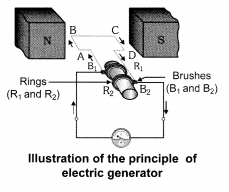
Working : When the armature coil ABCD rotates in a magnetic field produced by the permanent magnets, it cuts through the magnetic lines of force.
Due to the rotation of armature coil, the associated magnetic field changes and an induced electromagnetic force is produced in it. The direction of this induced electromotive force or current can be determined by using Fleming’s right hand rule.
In first half cycle the current flows in one direction by brush B1 and in second it flows in opposite direction by brush B2. This process continues. So the current produced is alternating in nature.
Functions of Brushes : Brushes in contact with rings provide the current for external use.
Question 17
When does an electric short circuit occur ?
Answer:
In a domestic circuit, short-circuit occurs when live and neutral wire come in direct contact with each other without any resistance. The resistance of the circuit becomes zero and excessive current starts to flow through it.
Question 18
What is the function of an earth wire ? Why is it necessary to earth metallic appliances ?
Answer:
Earth wire is a safety measure that provides a low resistance conducting path to the current. Sometimes due to excess heat or wear and tear, the live wire comes in direct contact with the metallic cover of the appliances, which can give an electric shock on touching them. To prevent from the shock the metallic part is connected to the earth through a three-pin plug due to which the current flows to the earth at the instant there is a short circuit.
It is necessary to earth metallic appliances because it ensures that if there is any current leakage in the metallic cover, the potential of the appliance becomes equal to that of the earth. The potential of the earth is zero. As a result, the person handling the appliance will not get an electric shock.


